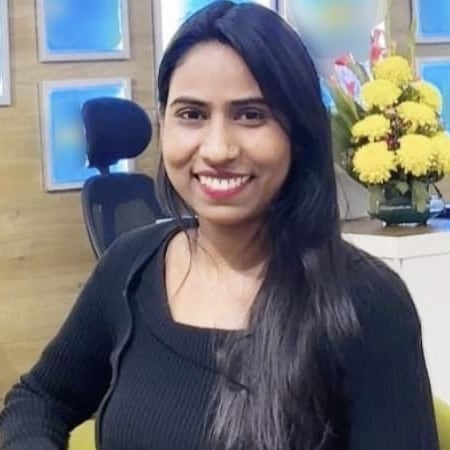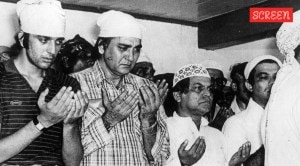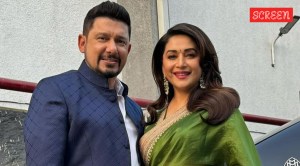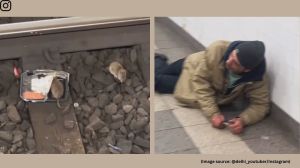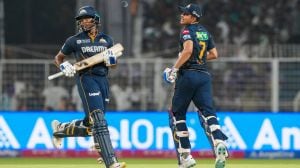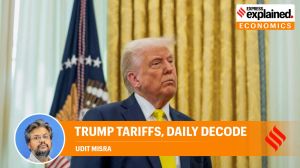UPSC Key: IMEEC initiative, US-China tariff war and Article 143
How is the power of the President to seek the SC’s opinion on important questions of law or fact relevant to the UPSC exam? What significance do topics like the IMEEC initiative, the US-China tariff war and left-wing extremism have for both the preliminary and main exams? You can learn more by reading the Indian Express UPSC Key for April 13, 2025.
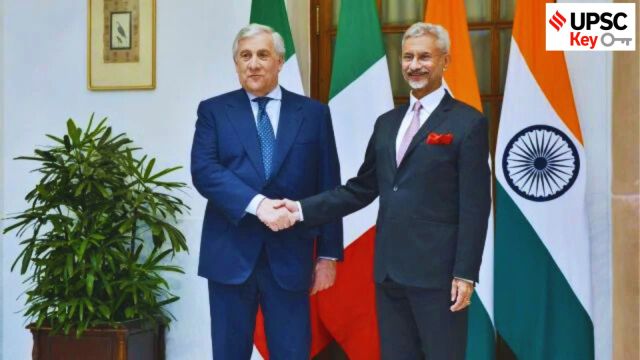 External Affairs Minister S Jaishankar and Italian Deputy Prime Minister Antonio Tajani. (Photo: X/ @DrSJaishankar)
External Affairs Minister S Jaishankar and Italian Deputy Prime Minister Antonio Tajani. (Photo: X/ @DrSJaishankar)Important topics and their relevance in UPSC CSE exam for April 13, 2025. If you missed the April 12, 2025, UPSC CSE exam key from the Indian Express, read it here.
FRONT
SC: ‘President ought to seek our opinion if Governor reserves Bill claiming it is unconstitutional’
Syllabus:
Preliminary Examination: Indian Polity and Governance – Constitution, Political System, Panchayati Raj, Public Policy, Rights Issues
Mains Examination: General Studies-II: Functions and responsibilities of the Union and the States, issues and challenges pertaining to the federal structure, devolution of powers and finances up to local levels and challenges therein
What’s the ongoing story: The Supreme Court judgement settling the dispute between Tamil Nadu Governor R N Ravi and the ruling DMK government over the clearing of Bills — while laying down a specific timeframe for the President and Governor to act in such cases — seeks to give itself a toehold in the law-making process.
Key Points to Ponder:
• Read Articles 143, 200 and 201 of the Constitution.
• What are the important constitutional provisions related to the Governor and President?
• Read about the functions and powers of the Governor and President?
• What are the Supreme Court’s jurisdictions?
• What are the major highlights of the Supreme Court judgement in the TN governor case?
• How will the Supreme Court’s 2025 judgement regarding Article 143 and the role of constitutional courts in reviewing the validity of bills reserved for presidential assent impact the principle of separation of powers?
• Why did the Supreme Court set a timeline for the president to take a decision on the bills reserved for consideration by the governor?
• What are the various issues of conflict between Centre-state relations?
• What are the issues regarding the power of the governor and president?
• What are the recommendations of the Sarkari Commission and the Punchhi Commission?
Key Takeaways:
• The April 8, 2025 judgement, by a bench of Justices J B Pardiwala and R Mahadevan, says that, invoking Article 143, the President “ought to” seek its opinion where the Governor has reserved the Bill for his/her consideration on the ground of “perceived unconstitutionality.”
• Article 143 deals with the power of the President to seek the SC’s opinion on important questions of law or fact.
• Acknowledging that it’s not mandatory for the government to accept its opinion, the SC added that the same “holds high persuasive value and should ordinarily be accepted by the legislature and the executive” and “merely because the jurisdiction under Article 143 is not binding does not undermine the principles used by this Court to determine the constitutionality of the bill.”
• It pointed out that in the 1978 decision in ‘In Re: The Special Courts Bill’, “the view taken” by the SC “was that consultative jurisdiction under Article 143 may avoid any possible challenges to the vires of a bill if it becomes an Act. On basis of the dictum in the said reference, we are of the considered view that constitutional courts are not precluded from making suggestions or opining about the constitutional validity of a bill before the same becomes a law.”
• The top court said, “This is because preventing a patently unconstitutional bill from being enacted saves not only public resources but also respects the wisdom of the legislature by providing the constitutional functionaries associated with the process of passage of a legislation, to review the bill and take appropriate actions…The President’s recourse to Article 143 also palliates any apprehensions of bias or mala fides in the Central government’s approach to bills reserved under Article 200.”
• Writing for the bench, Justice Pardiwala pointed out that such “constitutional obligation” can also be found in Sri Lanka and Republic of Kiribati.
• The Supreme Court pointed out that both the Sarkaria and Punchhi Commissions had “categorically recommended the President to seek the opinion of this Court under Article 143 in respect of bills that may be apprehended to be patently unconstitutional.”
• The ruling also spoke of the manner in which the SC would exercise its power in case of such a reference. It said that the court “in such situations…has to be mindful as to whether the reference received from the President under Article 143 pertains to pure legal questions regarding interpretation of the Constitution or questions that are in the nature of a policy consideration. In case of the latter, the Supreme Court, having regard to the relevant facts and circumstances, can refuse to express its advisory opinion upon being satisfied that the questions presented to it are purely socio-economic or political questions and have no relation to the Constitution.”
Do You Know:
• In setting timelines for Governors to act on Bills presented to them by the state legislatures, the Supreme Court has, for the first time, prescribed that the President should take a decision on the Bills reserved for consideration by the Governor within a period of three months from the date on which such reference is received.
• Calling for a decision within three months is significant because under Article 201 of the Constitution, no timeframe has been set for a Presidential decision.
• Article 200 specifically deals with the issue of granting assent to Bills. When a Bill passed by the legislature of a state is presented to the Governor, the Governor has four options: (1) grant assent to the Bill; (2) withhold assent to the Bills; (3) return the Bills for reconsideration; or (4) reserve the Bill for the consideration of the President.
• The proviso in Article 200 says the Governor must return the Bill “as soon as possible,” but does not prescribe a specific timeframe. An indefinite timeline in deciding on Bills can, in effect, amount to paralysing the elected government. Therefore, in recent ruling Supreme Court has set the timeline for Governors to decide on Bills. The court fixed maximum time limits of one to three months for Governors to take a call on Bills.
Other Important Articles Covering the same topic:
📍Knowledge Nugget: SC Verdict on TN Governor — Why it matters for UPSC
Previous year UPSC Prelims Question Covering similar theme:
(1) Which one of the following suggested that the Governor should be an eminent person from outside the State and should be a detached figure without intense political links or should not have taken part in politics in the recent past? ( UPSC CSE 2019)
(a) First Administrative Reforms Commission (1966)
(b) Rajamannar Committee (1969)
(c) Sarkaria Commission (1983)
(d) National Commission to Review the Working of the Constitution (2000)
(2) Consider the following statements:
1. In appellate jurisdiction, the Supreme Court has exclusive power to adjudicate upon disputes involving elections of the President and the Vice President.
2. In advisory jurisdiction, the President has the power to seek an opinion from the apex court under Article 143 of the Constitution
3. In original jurisdiction, the Supreme Court hears appeals from lower courts.
Which of the statement(s) given above is/are correct?
(a) 1 and 2 only
(b) 2 only
(c) 3 only
(d) 2 and 3 only
AG flags: President not in picture, should have been heard before top court ruled
Syllabus:
Preliminary Examination: Indian Polity and Governance-Constitution, Political System, Panchayati Raj, Public Policy, Rights Issues, etc.
Mains Examination: General Studies II: Functions and responsibilities of the Union and the States, issues and challenges pertaining to the federal structure.
What’s the ongoing story: Responding to the Supreme Court verdict fixing a three-month deadline for the President to clear Bills reserved for his/her consideration by the Governor, Attorney General R Venkataramani told The Indian Express Saturday that the President was not heard in the matter — and should have been.
Key Points to Ponder:
• What are the constitutional provisions related to the President?
• What are the powers and functions of the President?
• Office of Governor and President- Compare
• Read about the writ of mandamus.
• What implications does the Supreme Court’s 2025 verdict mandating a time limit for the President to act on Bills reserved by the Governor have for federalism and separation of powers?
• What is the legal and constitutional validity of the Supreme Court’s recommendation of a writ of mandamus against the President?
Key Takeaways:
• Asked about the verdict, the AG said: “The President was not heard. The President should have been heard (before the court decided on her powers under the Constitution).” He added: “The President was not in the picture at all” in the matter. Incidentally, the AG has made submissions on the powers of the Governor in the case.
• Former Attorney General KK Venugopal said that the SC was “absolutely right in putting the President and the Governor on the same pedestal” in the case when it involves the legislative process. While Article 200 of the Constitution deals with the Governor’s action, Article 201 deals with Bills “reserved by a Governor for the consideration of the President.” Simply put, Article 201 is a consequence of the Governor’s actions under Article 200.
• “In fact, where the Governor has some individual discretion in deciding whether to refer the Bills to the President or not, the President has no such power. She has to go by the aid and advice of the Cabinet,” Venugopal added.
• This was echoed by senior advocate Rakesh Dwivedi, who appeared for the Tamil Nadu government in the case. He said that the power of the President, under Article 201, was “very much an issue” in the case.
• A writ of mandamus against the President is unusual since Article 361 of the Constitution bestows legal immunity for the President and Governors.
• They “shall not be answerable to any Court for the exercise and performance of the powers and duties of his office or for any act done or purporting to be done by him in the exercise and performance of those powers and duties,” the provision states.
• The President or the Governor are not even made a party before the courts. Generally, the court issues notices to the Secretary of the Governor or the Union Home Ministry for the President in such disputes.
• The consequences of issuing the writ of mandamus against the Head of State could be a constitutionally fraught issue. Even on the issue of judicial appointments, where the SC has flagged timelines, the directions are to the Central government and not the President, under whose seal and signature appointments are made.
• Another senior government law officer said that the Court must have refrained from breaching “constitutional comity.”
Do You Know:
• A writ of mandamus is a court order commanding a government official, public authority, or lower courts to perform a specific act or duty they are legally obligated to do.
• President vs Governor: The key difference between the governor and the president is in the manner of appointment and removal — whereas the president is elected by the elected representatives of the country, the governor is appointed by the Union government alone. Whereas the president can only be removed by way of impeachment, the governor can be removed from office at the pleasure of the Union government.
Other Important Articles Covering the same topic:
Previous year UPSC Prelims Question Covering similar theme:
(3) With reference to the President of India, consider the following statements:
1. The President can be removed from office for violation of the Constitution.
2. He/She is eligible for re-election.
3. A person shall not be eligible for election as President if he holds any office of profit under the Government of India.
4. The emoluments, allowances and privileges of the President are specified in the Second Schedule.
How many of the statements given above are correct?
(a) Only one
(b) Only two
(c) Only three
(d) All four
In first softening on China, US exempts phones, laptops, chip machines from tariffs
Syllabus:
Preliminary Examination: Current events of national and international importance, Economic Development
Main Examination: General Studies II: Effect of policies and politics of developed and developing countries on India’s interests.
What’s the ongoing story: The United States government late Friday evening exempted phones, computers and other electronic products from reciprocal tariffs, a decision seen as the first major softening of its stance towards China. The move will spare companies like Apple, Samsung, Microsoft, HP and Dell which manufacture these products outside the US, from the high reciprocal tariffs President Donald Trump had announced on April 2.
Key Points to Ponder:
• Read about the recent development associated with Trump’s announcement of reciprocal tariff and its 90 days pause.
• What are tariffs? Why are tariffs imposed?
• What are the key reasons behind the recent US government’s decision to increase tariffs?
• Why 90-day pause on new tariffs?
• US-China tariff war— Know in detail.
• How are tariffs retaliated? How is China responding to Trump’s retaliatory tariffs?
• What strategies India is using to navigate potential trade negotiations with the U.S.?
• What can be the implications of protectionist trade policies, such as tariffs, on emerging economies like India.
• Read about the bilateral trade agreement between India and the USA?
Key Takeaways:
• The decision also reflects a potentially growing awareness within the Trump camp that unilaterally escalating the tariff war to target Beijing could have ramifications for some of its most important domestic companies as well as consumers, who may have to pay more for items imported from China, particularly electronics.
• In a notification issued by the US Customs and Border Protection, the US administration has excluded 20 product categories including smartphones, laptop computers, hard drives and computer processors, chip making equipment, and certain semiconductor devices like memory chips — a substantial part of which are either made in China, or assembled elsewhere by using Chinese-made parts. The exclusions are retroactive to 12:01 am on April 5.
• The fresh exemption means the electronic products, including iPhones, will not be impacted by the US tariff on China, and the baseline 10 per cent levy that has been imposed on other countries. This also brings down the effective tariff rate on Beijing.
• Since April 2, when Trump first announced new tariff rates on several countries, there have been several flip flops by the US administration, as various countries reacted in different ways to the measure – some like China decided to impose tariffs on US products, which led the US to increase its tariff rate on the country, while other like India have refrained from any tariff-related retaliation and have instead looked to secure a trade deal with Washington.
• Earlier this week, the US administration paused reciprocal tariffs on 75 countries for 90 days, including India, while imposing a steep 125 per cent tariff on China in response to its retaliatory measures. With the latest US move, some electronics exports from the country to the US are safe from the tariff wars, for now.
Do You Know:
• China and the United States edged dangerously close to a full-blown trade war on Tuesday after President Donald Trump announced a staggering 104 per cent tariff on all Chinese imports. Locked in an escalating showdown, neither side showed signs of backing down — with Beijing vowing to resist US pressure “to the end.”
• Trump initially imposed a 34 per cent tariff on Chinese goods, which was swiftly met with an equivalent retaliatory measure by Beijing. In response, the US added another 50 per cent in duties. When combined with earlier levies from February and March, the total tariff burden on Chinese imports under Trump’s second term increased to 104%, bringing fears of a near-embargo scenario.
• But amid global pushback, US President Donald Trump announced a 90-day pause on tariffs, however, China is excluded from the pause, and instead, the tariff rate has been increased to 125%.
• Beijing will impose 125 per cent tariffs on US goods from Saturday (April 12), up from the 84 per cent previously announced, news agency Reuters quoted the Chinese finance ministry said on Friday. This comes after the Trump administration decided to pause tariffs for 90 days on many countries, but hit China with a 145 percent tariff amid the ongoing trade wars.
• China, which was America’s second-largest source of imports last year, shipped $439 billion worth of goods to the US, compared to $144 billion in American exports to China. The rising tariffs now threaten to hit domestic industries hard, with businesses warning of cost surges, layoffs, and reduced competitiveness.
Other Important Articles Covering the same topic:
📍UPSC Issue at a Glance | Tariff war: 4 Key Questions You Must Know for Prelims and Mains
Previous year UPSC Mains Question Covering similar theme:
What are the key areas of reform if the WTO has to survive in the present context of ‘Trade War’, especially keeping in mind the interest of India? (UPSC CSE 2018)
GOVT & POLITICS
India, Italy agree to take forward IMEEC initiative
Syllabus:
Preliminary Examination: Current events of national and international importance
Mains Examination: General Studies-II: Bilateral agreements involving India and/or affecting India’s interests, Effect of policies and politics of developed and developing countries on India’s interests, Indian diaspora.
What’s the ongoing story: India and Italy have decided to expand cooperation in areas of trade, defence, clean energy and high technology while agreeing to work jointly in implementing the ambitious India-Middle-East-Europe-Economic Corridor (IMEEC).
Key Points to Ponder:
• Read about the Joint Strategic Action Plan (JSAP) 2025-29 between India and Italy.
• What is the history of India and Italy’s bilateral ties?
• What are the areas of cooperation between both the countries?
• What is the India-Middle-East-Europe-Economic Corridor (IMEEC)?
• What are the benefits associated with IMEEC?
• What are the challenges in India and Italy’s bilateral ties?
• Map work: Location of Italy and bordering countries, major mountains and rivers of Italy (refer to Atlas)
Key Takeaways:
• Ways to deepen India-Italy cooperation under the framework of Joint Strategic Action Plan (JSAP) 2025-29 figured prominently during talks between External Affairs Minister S Jaishankar and Italian Deputy Prime Minister Antonio Tajani Friday evening.
• Tajani, also the Minister of Foreign Affairs and International Cooperation, is on a two-day visit to India from Friday. During the delegation-level talks, Jaishankar and Tajani reviewed the growing bilateral cooperation under the ambit of JSAP, which included the areas of trade and investment, defence and security, space, science and technology, clean energy transition and people-to-people ties, the Ministry of External Affairs (MEA) said Saturday.
• It said the two ministers noted the vast potential of India-Italy cooperation in areas of AI, cyber, telecom, digital technologies, renewable energy, biofuels, education and mobility of youth and professionals, among others.
• The JSAP was announced by PM Narendra Modi and Italian PM Giorgia Meloni following their last November meeting at Rio de Janeiro. Jaishankar and Tajani reiterated their commitment to elevating the bilateral strategic partnership and ensuring concrete outcomes from the JSAP, the MEA said in a statement.
• It added that the visit and engagements of Tajani were instrumental in taking forward the strategic partnership and diversifying bilateral cooperation across domains as per the JSAP.
• Jaishankar and Tajani renewed their commitment to take forward the strategic initiative IMEEC, according to the MEA. In this context, the Jaishankar welcomed Italy’s appointment of a special envoy for IMEEC.
Do You Know:
• India and Italy are ancient civilisations with links going back 2,000 years. Italian port cities were important trading posts on the spice route. The Venetian merchant Marco Polo traveled to India in the 13th century and wrote about his experiences.
• In the last century, Nobel Laureate Rabindranath Tagore visited Italy in May-June 1926, a visit arranged by Carlo Formichi, a Professor of Sanskrit at the University of Rome.
• Mahatma Gandhi visited Rome in December 1931 on his way back from the Round Table Conference in London. Leaders of the Indian freedom struggle read the works of the Italian revolutionary Mazzini.
• Indian troops, serving with the British Indian Army, were deployed in Italy during World War II, fighting against the Germans and Mussolini’s forces.
• After Independence, political relations between India and Italy were established in 1947. Since then, there has been a regular exchange of visits at political and official levels between both countries, including several visits by Heads of States.
Other Important Articles Covering the same topic:
📍Defence to space, India & Italy announce 5-year action plan
UPSC Prelims Practice Question Covering similar theme:
(4) Which of the following countries shares a land border with Italy?
1. Switzerland
2. France
3. Slovenia
4. Germany
5. Austria
Select the correct answer using the code given below:
(a) 1, 2 and 3 only
(b) 1, 2, 3 and 4 only
(c) 1, 2, 3 and 5 only
(d) 1, 2, 3, 4 and 5
EXPRESS NETWORK
As Maoists make ‘peace offer’, why govt is not jumping at it, fears ‘time-buying tactic’
Syllabus:
Preliminary Examination: Current events of national importance
Mains Examination: General Studies-II,III: Government policies and interventions, Linkages between development and spread of extremism, role of external state and non-state actors in creating challenges to internal security.
What’s the ongoing story: During his recent visit to Chhattisgarh’s Dantewada, Union Home Minister Amit Shah had a message for Maoists. Addressing them as “brothers” and requesting them to drop their weapons, Shah reiterated that the government had a March 2026 deadline to end Left Wing Extremism in the country. “You people are one of us. Whenever a Naxal is killed, no one feels happy,” Shah said.
Key Points to Ponder:
• What is naxalism?
• What is Left-wing Extremism?
• Read about the Origin of Naxalism in India.
• Know about the Maoist-affected areas in Chhattisgarh.
• What is the Naxal Surrender policy?
• What is a Red Corridor region?
• What initiatives have been taken by the government to counter Naxalism?
• What are the government efforts to bring development to Naxal-affected areas?
• How is Naxalism different from terrorism?
• What strategy should be adopted to counter Naxalism in the affected areas?
Key Takeaways:
• His statement came days after a letter purportedly from the outlawed Communist Party of India (Maoist) offered a ceasefire under certain terms and conditions. The letter, released on April 2, was in the name of Abhay, the nom de guerre of the rebel party’s Politburo member Mallojula Venugopal Rao, 69.
• The letter claimed that peace talks had been held by a committee in Hyderabad last month, and that the Maoists would immediately call for a “ceasefire” and initiate peace talks if the security forces stopped setting up police camps and running anti-Naxal operations across Chhattisgarh, Maharashtra’s Gadchiroli, Odisha, Jharkhand, Madhya Pradesh, and Telangana.
• However, police officials believe it is a tactic by the rebels to buy some time to regroup. Former Chhattisgarh DGP and Naxal expert R K Vij told The Indian Express it was the second time Maoists had offered a ceasefire, and that the peace talks would fail again unless the Maoists ended their armed struggle.
Do You Know:
• Chhattisgarh is the only state in which Maoists continue to have a significant presence, and retain the capability to mount big attacks. Chhattisgarh, and to a lesser extent Jharkhand, is a part of the government’s “final push” against LWE. This has seen central forces such as CRPF setting up bases deeper inside Maoist strongholds such as the jungles of Abujhmad. In the past few years, more than two dozen bases have been set up in Abujhmad, with Kanker’s Rowghat jungles too seeing new camps.
Other Important Articles Covering the same topic:
📍Ruthless strategy to deal final blow, will end Naxalism by March 2026: Shah
📍Whenever a Naxal is killed, no one feels happy: Shah’s message to Maoist ‘brothers’ in Bastar
Previous year UPSC Mains Question Covering similar theme:
Naxalism is a social, economic and developmental issue manifesting as a violent internal security threat. In this context, discuss the emerging issues gets a multilayered strategy to tackle the menace of Naxalism. (UPSC CSE 2022)
Left Wing Extremism (LWE) is showing a downward trend, but still affects many parts of the country. Briefly explain the Government of India’s approach to counter the challenges posed by LWE. (UPSC CSE 2018)
ECONOMY
From nuclear energy to EVs: Need to keep all tech options open, says PSA
Syllabus:
Preliminary Examination: Current events of national importance and Development
Mains Examination: General Studies-II, III: Government policies and interventions, indigenization of technology and developing new technology
What’s the ongoing story: The recent regulatory clearance by the US Department of Energy (DoE) for US company Holtec International to transfer technology for fabricating small modular reactors (SMRs) is a significant development that expands the range of options India has in its progress towards clean energy, said Principal Scientific Advisor Ajay Kumar Sood.
Key Points to Ponder:
• What are small modular reactors (SMRs)?
• How are SMRs different from traditional nuclear reactors?
• Read about India’s civil nuclear program.
• How can Small Modular Reactors contribute to India’s clean energy transition?
• “Nuclear energy is inevitable for India’s net-zero transition.” Critically examine this statement.
• What are India’s potential benefits from entering the manufacturing value chain for SMRs?
• What are the limitations of lithium-ion battery technology in India’s electric vehicle policy?
• What are the challenges faced by India in developing SMRs?
• Read about the Nuclear Energy Mission.
Key Takeaways:
• “Nuclear energy is inevitable, because if you look at the energy mix, which is required for net zero carbon by 2070, nuclear energy is integral to this energy transition period. You can’t get away from that. Given that, whatever is required: whether it is SMR or whether it is 500 MW (electric) conventional reactors or any other reactor type, all have to be used now,” said Sood.
• SMRs, he told The Indian Express, have a distinct advantage. “If one needs a very focused energy supply, like for data centers, an SMR offers a possible application, even if it (cost of generation) is not economical”.
• On March 26, as first reported by The Indian Express, the US approval cleared Holtec International’s application for specific authorisation with respect to the restrictive regulation that is referred to as “10CFR810”.
• This authorisation essentially permits Holtec, with conditions, to transfer “unclassified SMR technology” to three firms in India: its regional subsidiary Holtec Asia; Tata Consulting Engineers Ltd; and Larsen & Toubro Ltd. This came two decades after the India-US civil nuclear deal was inked.
• Sood’s prescription for nuclear energy finds a strong echo when it comes to electric vehicles. On EV mobility, an R&D roadmap report last year from the PSA’s office kept the technology option open. However, within sections of the government, much of the focus is on one technological pathway: battery electric vehicles. Asked about this, Sood flagged the need for options here, too, looking at what he called a range of “electro chemistries.”
• “I completely agree, multiple technologies (is the way forward). Because if you take the fuel cell (technology)…green hydrogen, and the fuel cell (tech) is a very, very good option, along with EVs (battery electrics). I’m not saying EV should be (ruled) out, but in the case of EVs, I don’t think that lithium chemistry (for batteries) is the end of the world… Other electro chemistries have to be tried, and are being tried,” he said.
Do You Know:
• The Government of India is promoting the indigenous development of SMRs, occasionally calling them Bharat SMRs, with the new ₹20,000 crore mission aimed at making a significant impact in this regard. India is pushing for a leadership slot in this small reactor space, both as a way of fulfilling its commitment to clean energy transition, and bundling SMRs as a technology-led foreign policy pitch.
• SMRs are essentially advanced small nuclear reactors that have a power capacity of 30MWe to 300 MWe (megawatt electrical) per unit. Conventional nuclear reactors, the kind which are currently installed in India and elsewhere, usually have capacities to produce 500 MW of electricity or more.
• The relatively simpler and modular design of SMRs—enabling their components to be assembled in a factory instead of being constructed on-site—lowers costs and allows flexible deployment, making them a much more attractive proposition in recent years.
• While lots of different types of SMRs are being developed, there are currently four main types, each using a different coolant to manage the extreme heat of a nuclear fission reaction — light water, high temperature gas, liquid metal, and molten salt.
Other Important Articles Covering the same topic:
📍Knowledge Nugget: How is Nuclear Energy Mission and Small Modular Reactors relevant for UPSC Exam?
📍Knowledge Nugget: India’s three-stage nuclear programme — A must-know for UPSC exams
Previous year UPSC Prelims Question Covering similar theme:
(5) Which of the statements about Small Modular Reactors (SMRs) are correct?
1. It aims to achieve net-zero emissions while ensuring energy security.
2. These have a power generation capacity ranging from less than 30 MWe to 300+ MWe.
3. These are cost-effective alternatives to conventional large nuclear reactors.
4. They are suitable only for on-grid and not for off-grid applications.
Select the correct answer using the codes given below:
(a) 1 and 2 only
(b) 2, 3 and 4 only
(c) 3 and 4 only
(d) 1, 2 and 3 only
| ALSO IN NEWS | |
| RBI repo rate cut impact: SBI, Bank of India cut FD rates on select tenors | Days after the Reserve Bank of India (RBI) slashed the repo rate by 25 basis points (bps), banks, including the State Bank of India (SBI), have announced deposit rate cuts on select maturities. This reduction in FD rates will impact depositors, especially senior citizens, who are dependent on interest earned from fixed deposits parked with banks. Earlier this week, the RBI’s Monetary Policy Committee (MPC) reduced the repo rate by 25 basis points (bps) to 6 per cent for the second consecutive policy review, taking the cumulative cut of 50 bps in the last two months. One basis point (bps) is one-hundredth of a percentage point. |
| Iran, US hold ‘productive’ talks in Oman, agree to resume next week, says Tehran | Iran and the US held “productive” talks in Oman Saturday and agreed to reconvene next week, Tehran said, a dialogue meant to address Tehran’s escalating nuclear programme with President Donald Trump threatening military action if there is no deal. |
| ‘Tariffs by America could shrink global trade by 3%’ | Global trade could shrink by three per cent and exports could see a shift from markets such as the US and China to India, Canada and Brazil due to tariffs imposed by the US, a top UN economist has said.US President Donald Trump unveiled a massive tariff plan last week. The White House later announced a 90-day pause on “reciprocal tariffs” for most countries except China, which in turn decided to impose 125 per cent tariffs on US imports. |
| Prelims Answer Key |
| 1. (c) 2. (b) 3. (d) 4. (c) 5. (d) |
🚨 Click Here to read the UPSC Essentials magazine for March 2025. Share your views and suggestions in the comment box or at manas.srivastava@indianexpress.com🚨
Subscribe to our UPSC newsletter. Stay updated with the latest UPSC articles by joining our Telegram channel – Indian Express UPSC Hub, and follow us on Instagram and X.
Must Read
Buzzing Now
Apr 22: Latest News
- 01
- 02
- 03
- 04
- 05

